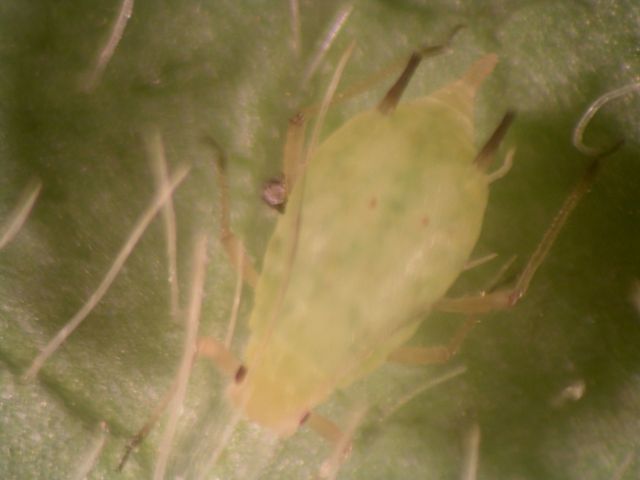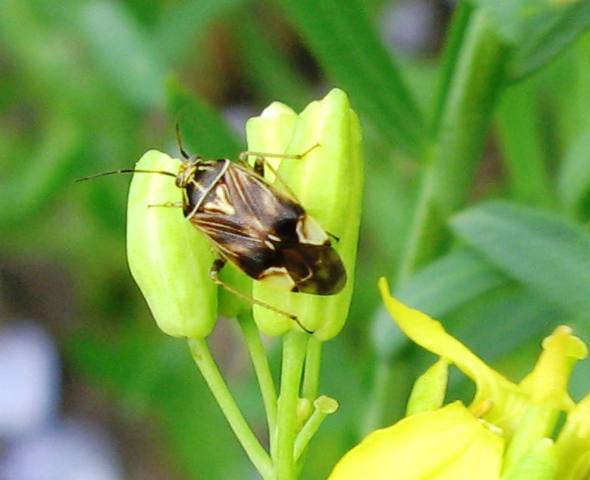Manitoba Insect & Disease Update: August 15, 2014
- John Gavloski, Entomologist
Manitoba Agriculture, Food and Rural Development
Phone: (204) 745-5668
Fax: (204) 745-5690. - Vikram Bisht, Plant Pathologist
Manitoba Agriculture, Food and Rural Development
Phone: (204) 745-0260
Fax: (204) 745-5690
To be placed on an E-mail list so you will be notified immediately when new Manitoba Insect and Disease Updates are posted, please contact John Gavloski at the address or numbers listed above.
- There are about 670 species of aphids in Canada, and the way aphids colonize and interact with plants varies greatly. For some aphid species on some crops economic thresholds can be relatively low because of the way the aphids colonize and affect the plant. For soybeans and soybean aphid the economic threshold and potential of aphids to cause yield loss is at the other end of the spectrum, it takes a lot of aphids to do economic yield loss.
- The economic threshold for aphids in soybeans is 250 aphids per plant, and the population is increasing, and the plants are in the R1 (beginning bloom) to R5 (beginning seed) growth stages.
- The reason that "and the population is increasing" is part of the threshold is because the actual economic injury level, where control costs will equal yield loss, is actually about 670 aphids per plant. The economic threshold, where control is suggested, has been set much lower than 670 to allow time for the spray to be applied before increasing populations could potentially reached 670 per plant. The population doubling time for soybean aphids can be as low as about 7 days if they are not being regulated well by natural enemies or weather.
- Aphid populations do not always continue to increase. So we can not assume that because a certain number is present this week that even more will be present the next week. Populations can plateau or start decreasing due to natural enemies or weather conditions or events.
- When the value of the soybean crop is high, it is a mistake to try to lower the economic threshold below 250 per plant and the population increasing. There is already a large gap between the economic injury level and the economic threshold that is suggested. But what also needs to be considered is that the damage boundary, which is the lowest insect pressure where any yield loss can be detected, is well above the 250 economic threshold that used. So it would be illogical to try to reduce a threshold which is already below a level where yield loss can not be detected. Although economic injury levels (where control cost = yield loss) do change with commodity prices, damage boundaries do not. And given that aphid populations do not increase in linear fashions, there would be no advantage, and potential costs, to spraying at levels below the suggested economic threshold for soybean aphids. The research publication where the economic thresholds for soybean aphids are presented states "setting an economic threshold at lower aphid densities increases the risk to producers by treating an aphid population that is growing too slowly to exceed the economic injury level in 7 days, eliminates generalist predators, and exposes a large portion of the soybean aphid population to selection by insecticides, which could lead to development of insecticide resistance (Journal of Economic Entomology. 2007: 1258-1267).

Figure 1. Soybean aphid.
Oilseed Crops
Lygus Bugs in canola - It is the early podding stage of canola that is most sensitive to potential damage form Lygus bugs. With adequate soil moisture, plants will compensate well for loss of flowers. It is feeding directly to seeds when the seeds are young that has the highest potential to reduce yields if levels of Lygus bugs are high enough.
The economic thresholds for Lygus are actually the same as the economic injury levels, in contrast to the economic threshold for soybean aphid. So for Lygus bugs the economic thresholds can be adjusted for the value of the crop and the cost of the control. At the current value of canola and control costs the economic threshold will be in the range of 10 to 15 Lygus bugs per 10 sweeps.
Once canola has reached the R5.3 stage, where seeds in the lower pods are mottled green-brown, the seeds are mature enough that Lygus bugs are no longer considered an economic risk. There are no economic thresholds for Lygus bugs in canola at the R5.3 stage and beyond.

Figure 2. Lygus bug on canola
Lygus bugs in flax - It is not unusual to find Lygus bugs in flax that is in flower or the early stages of seed development. There has been research that has looked for potential effects on yield of flax from Lygus bugs, but even at higher levels of Lygus bugs significant effects on yield could not be detected. A study by entomologists from Agriculture and Agri-Food Canada in Winnipeg found that under good growing conditions populations of up to 100 Lygus bugs per 10 sweeps were not economical (The Canadian Entomologist 132 (2000): 369-371). This has been the only study on the economics of Lygus bugs in flax, so currently all we can conclude is that if growing conditions are good, even at the high levels of Lygus bugs damage should not be economical.
Bertha Armyworm- So far levels of larvae of bertha armyworm have been low and not of economic concern in canola. The one exception is a canola field near The Pas where about 1 acre was sprayed for what was apparently a high isolated patch of bertha armyworm.
The final map and summary of the program for monitoring adult moths of bertha armyworm is posted on the MAFRD website at:
http://www.gov.mb.ca/agriculture/crops/insects/bertha-armyworm-forecast.html
Grasshopper Survey
A reminded for those participating in the grasshopper survey, that August is when these counts need to be done. What we are doing is estimating the populations of adult grasshoppers, the data of which will be interpreted with weather data during the egg laying period of the grasshoppers to produce a forecast map for 2015. I stress the word estimate; it will not be possible to accurately count grasshoppers along a field edge or ditch area as they will be moving around as you get near the area of the count. But estimate of what is present gives us some idea of the relative numbers that are present in different areas.
The protocol and data sheet for the grasshopper survey is at: http://www.gov.mb.ca/agriculture/crops/insects/mb-grasshopper-survey.html
